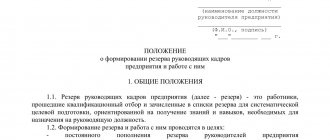Why are regulations drawn up on the adaptation of employees at the enterprise?
Adaptation is a technology designed for the effective and rapid inclusion of new personnel into the work of the enterprise and team, and professional implementation in a new position. To monitor the process, a resolution is drawn up on the progress of assimilation into the work process and the team of new personnel.
The entire course of the adaptation must be planned, outlining each stage and its time frame. A separate responsible person is responsible for each step of the process. For this purpose, a regulation on personnel adaptation is drawn up with clear regulation of each stage for the preparation and adaptation of new personnel to work at the enterprise. The adaptation sheet is prepared by the line managers of the department; he is also responsible for familiarizing employees with the documents that the employee must sign from the first day of work.
Structure of the adaptation provision
The program for the adaptation of new personnel is based on the Regulations on the adaptation of personnel. The paper contains a description of the organization's personnel concept, in the context of the assimilation of newly arrived workers. This is the last step in developing an assimilation model for the adaptation of fresh personnel. The program is developed on the basis of the Regulations on Personnel Adaptation. The purpose of the resolution is to standardize, streamline and approve the progress of the trial period at each level of the enterprise
What tasks does it perform?
- Defines basic concepts;
- Adaptation goals;
- Establishes the conditions for regulating the assimilation process;
- Regulates the form of communication with new personnel;
- Determines the progress of process control;
- Regulates the rights and obligations of the employer, employee, and all involved persons.
A successful example of adaptation
Adaptation of personnel in the organization, using the example of one of the companies, occurred as follows. More experienced employees were assigned the role of mentors. The employee in charge of the newbie onboarding system downloaded data from the accounting system daily about people who needed to return to work soon.
Each person was manually assigned a different mentor. They had to work in pairs. Mentors were selected from any department, except the one where the newcomer would work in the future. It is more convenient to work in pairs, taking into account different workload schedules, and it is easier to communicate with strangers. Once mentors were approved, automatic notifications were sent to them, and a reminder was added to the calendar about the day the new employee would start.
The day before, the mentor called the newcomer for correspondence acquaintance and so that in the future the newcomer would contact him upon arrival at the office to meet and discuss work issues. The mentor must check whether everything is ready to accept a new employee, make sure that the workplace is organized, and remind the head of the department where the newcomer is getting a job about the new employee’s departure.
On the first day, a pair of mentors meet the new recruit in the morning, talking about the available information on the corporate portal. This takes a couple of hours. This meeting makes it clear to the employee that he was expected. On all other days, if questions arise, he can contact his mentors, ask them questions to solve any situation, from a broken chair to a conflict situation with another colleague, and they help resolve them.
How to draw up a regulation on personnel adaptation?
There is no established procedure for drawing up a resolution on the adaptation of new personnel; it is not in the Labor Code. But nevertheless, certain conditions must be met when drawing up a paper.
The document outlines the enterprise’s assimilation system, so it must contain specific information about the rights and responsibilities of the new personnel. The content of the paper varies, depending on the focus of the enterprise and personnel policy.
It needs to describe the methodology, conditions and results of the assimilation process. It is necessary to clearly state the progress of the probationary period, and the list of persons responsible for its completion. The most important points in the document are the activities during the probationary period, and who is responsible for this.
Who approves the document?
The document is submitted to the head of the HR department for signature. But it is not he who asserts the position. The signature of the head of the enterprise is required for approval. The document may contain stamps from the heads of various departments who participated in the development of the regulation.
Shelf life
How long is a document kept in the HR department? The regulations for storing various documents in the archive or personnel department are determined by the Labor Code of the Russian Federation, regarding papers of different categories. According to the law, documentation according to the storage period is classified into types:
- Limited term securities;
- Papers with a permanent storage period;
- Until the expiration date;
- Before creating a new version of the document;
- Poste restante.
The document with the resolution on the adaptation of new employees is a type of disciplinary paper and is retained for 36 months from the date of entry into force.
Example of a provision on adaptation of new employees
There is no single standard, but as a rule it contains such items as: basic regulations, a plan for working with an employee on a probationary period, regulations for the adaptation of employees, detailed familiarization with the direction of the organization, certification after passing the probationary period. The items in these sections are written depending on the focus of the enterprise.
Regulations on personnel adaptation - sample
Goals and objectives of personnel adaptation in the organization
Organizing the management of career guidance and personnel adaptation is the work of the personnel department and the head of the department where the new employee works.
Adaptation is an important point in personnel management, which determines which personnel will work in the organization, what the psychological climate in the team is and how well and productively employees will perform their duties.
https://www.youtube.com/watch?v=ytpolicyandsafetyru
The goals of the work on adaptation of new employees are:
- accelerating the process of introducing a new employee to the job, familiarizing him with his job responsibilities;
- complete elimination or reduction of staff turnover in the organization;
- motivating employees to be interested in the result, to be motivated to perform their job duties better, and to give maximum return to their work;
- increase in labor productivity;
- improving the psychological climate in the team.
Only taking into account all the listed factors and working in this direction will give the best result.
Encouraging mentors
An important role in the personnel adaptation system is played by the motivation of mentors to obtain the fastest results, the rapid acquisition of new skills by the student and the reduction of time for a new employee to transition to full-fledged independent work.
A system for encouraging mentoring work is also necessary because a specialist teaching a newcomer spends his working time on a student, and, accordingly, becomes less effective as an employee.
During the adaptation period of a new employee, an experienced employee could perform more operations, conclude a larger number of contracts, etc.
It is unacceptable to reward a mentor financially by reducing the bonus or allowances for the employee being trained.
This is a direct violation of labor laws and will result in penalties.
Incentives for the mentor can be expressed in an increase in the size of the bonus for the duration of the newcomer’s training and, based on the results of monitoring the progress of adaptation, the assignment of an additional payment for mentoring.
In addition to material motivation, other methods of encouragement can be used. For example, give additional days off, thanks for successful mentoring, etc.
What does the plan look like?
There is no single established algorithm for document development. The reason is the need to orient the document to specific conditions in the organization.
However, there are a number of features common to different programs:
- include several stages;
- have similar goals.
| Term | Actions | Involved personnel |
| Adaptation Day No. 1 |
| Human Resources Department Occupational Safety Specialist |
| Personnel adaptation week No. 1 |
| Head of department, mentor |
| Onboarding Month #1 |
| Head of department, mentor |
| Adaptation Months #2-3 |
| Head of department, mentor |
We invite you to familiarize yourself with: 360 degree assessment method – Methodology and example of a questionnaire
The result of a successfully implemented adaptation program will be an indicator of the duration of an employee’s work in a particular institution. The success of the adaptation procedure largely depends on the second party involved in the process - the manager or mentor. It is their desire to help the newcomer that will help the latter get used to the organization as quickly as possible.
What does the adaptation program consist of?
An employee adaptation program is a plan for introducing an employee to a position. This document is needed to apply a uniform approach to the adaptation procedure across departments of the organization. The document is an extensive list of actions for the adapting employee and for his supervisor, who will help adapt to new working conditions.
For an employee, the most difficult period is the first two to three months, which usually coincide with his probationary period. Often the duration of the program is equal in length to this period.
An optimally formed program is characterized by the following features:
- clear planning;
- clear content;
- strict distribution of roles and tasks.
The document consists of two parts: general and individual.
https://www.youtube.com/watch?v=ytdevru
1. The general part, which helps to form a general idea of the enterprise, its features, hierarchy, established relationships between departments, distribution of functionality, working conditions, etc.
Comprises:
- orientation introductory conversation;
- personal acquaintance with the enterprise and personnel;
- getting to know the place where work duties are performed;
- orientation conversation with the manager heading the structural unit.
2. The individual part, which is formed by the immediate supervisor who supervises the induction of the employee. It is agreed upon with the head of the area of activity and the head of the HR department. This component helps the employee obtain detailed information about the activities of the organization and the direct functional responsibilities of the employee.
Comprises:
- inauguration plan;
- entry assessment plan;
- definitions of a curator-mentor;
- employee report on the results of work performed, information about ratings and feedback from mentors and supervisors.









